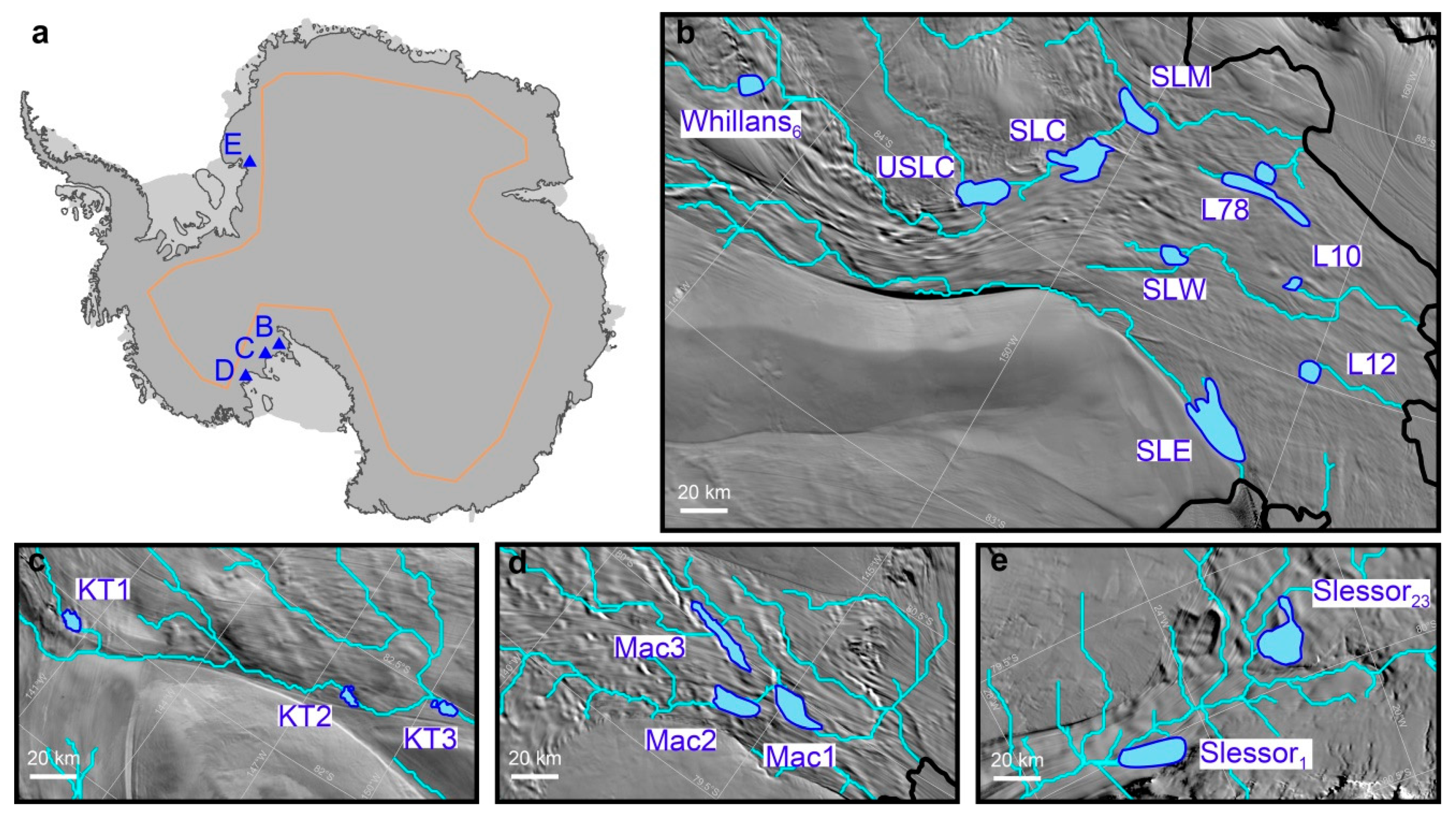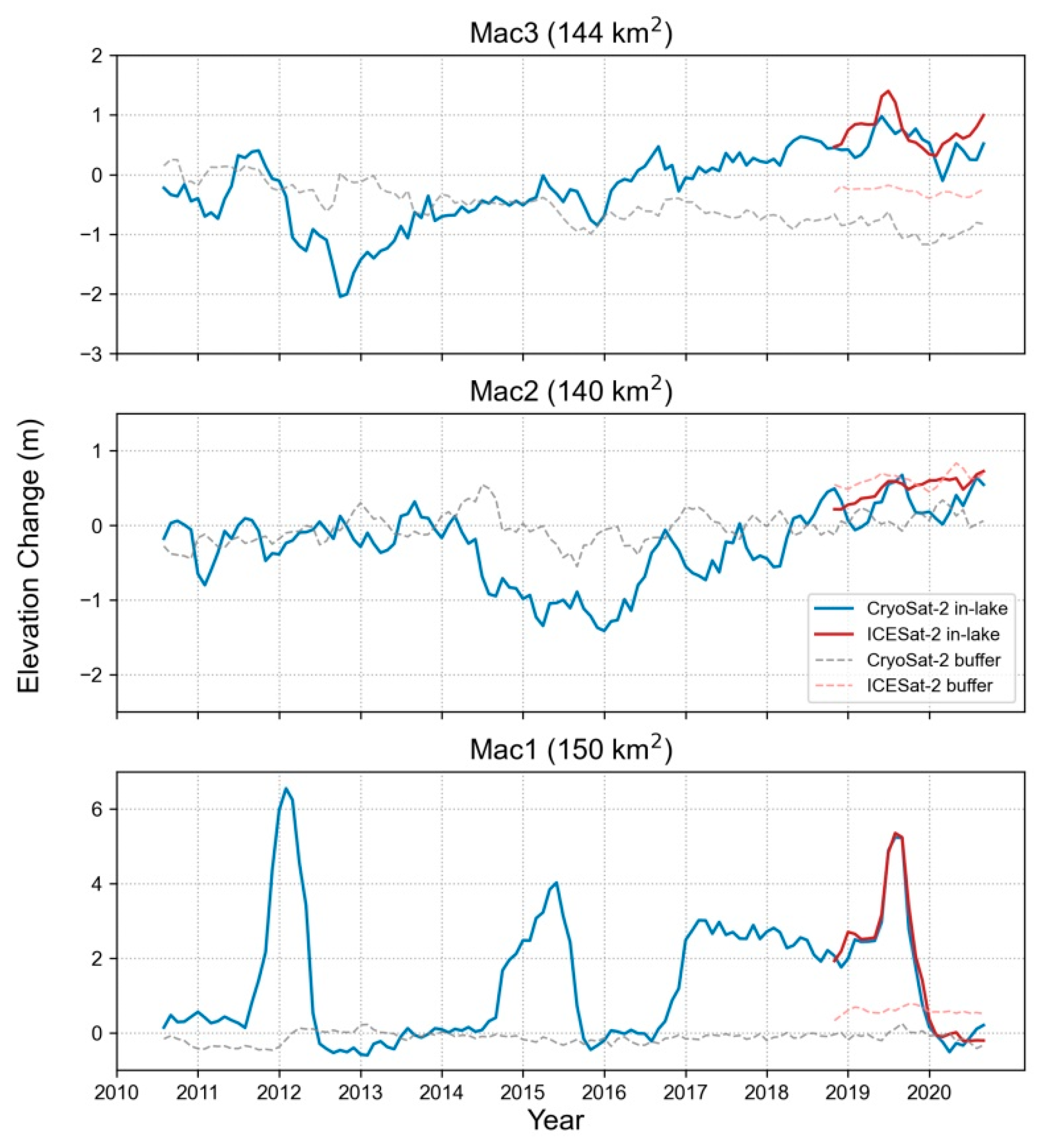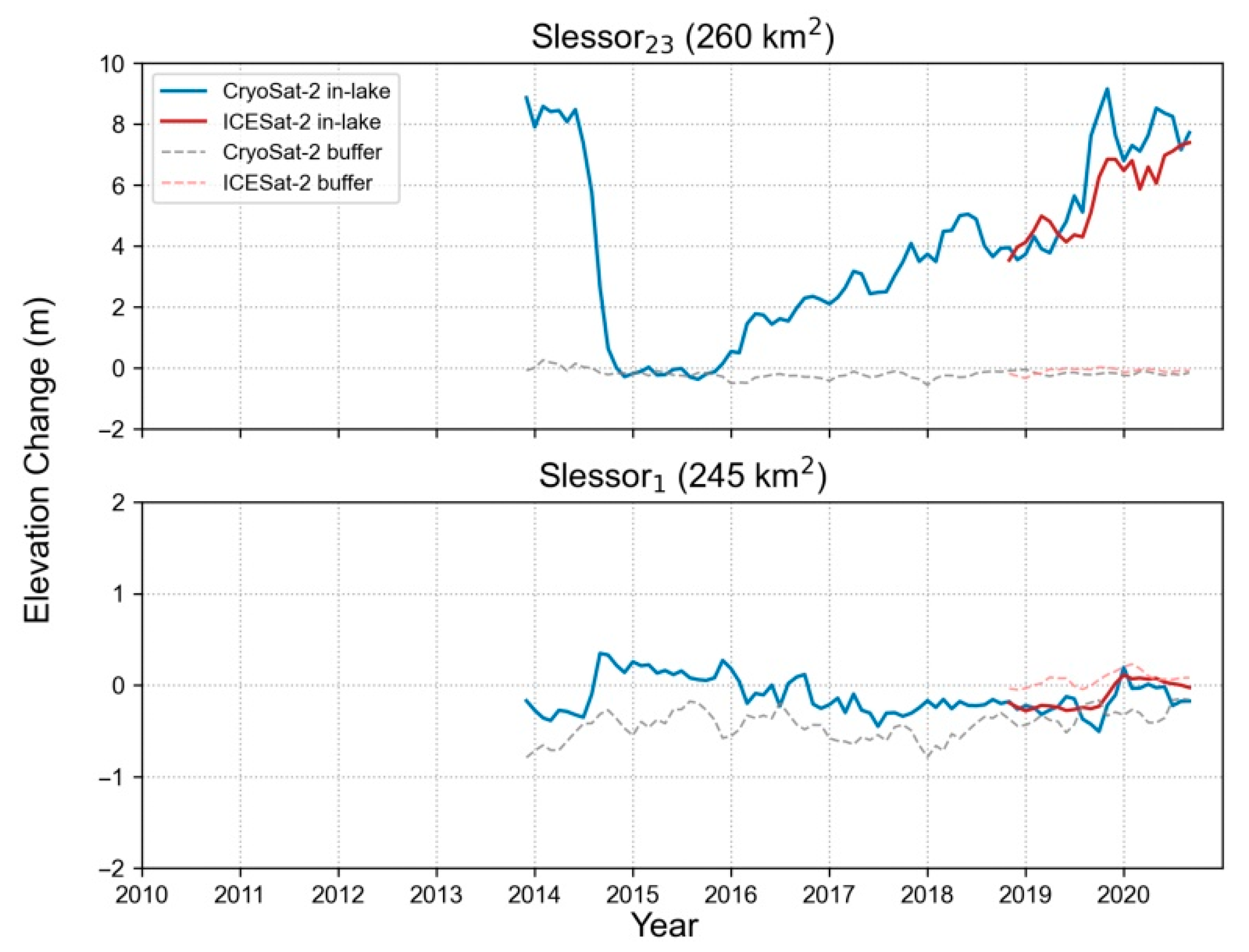Monitoring the Hydrological Activities of Antarctic Subglacial Lakes Using CryoSat-2 and ICESat-2 Altimetry Data
Abstract
:1. Introduction
2. Data
2.1. CryoSat-2
2.2. ICESat-2
2.3. REMA
3. Methods
3.1. Creation of CryoSat-2-Based Elevation Change Time Series
3.1.1. Data Preprocessing
3.1.2. Creation of Elevation Change Time Series
3.2. Creation of ICESat-2-Based Elevation Change Time Series
3.3. Hydraulic Potential and Simulation of Subglacial Water Pathways
4. Results
4.1. Cross-Validation
4.2. Time Series of the Ice Surface Elevation Changes
4.2.1. Mercer and Whillans Ice Streams
4.2.2. Kamb Ice Stream
4.2.3. MacAyeal Ice Stream
4.2.4. Slessor Glacier
5. Discussion
5.1. Hydrological Analysis
5.2. The Limit of the Data and Method
6. Conclusions
Author Contributions
Funding
Institutional Review Board Statement
Informed Consent Statement
Data Availability Statement
Acknowledgments
Conflicts of Interest
References
- Siegert, M.J.; Carter, S.; Tabacco, I.; Popov, S.; Blankenship, D.D. A revised inventory of Antarctic subglacial lakes. Antarct. Sci. 2005, 17, 453–460. [Google Scholar] [CrossRef] [Green Version]
- Gray, L.; Joughin, I.; Tulaczyk, S.; Spikes, V.B.; Bindschadler, R.; Jezek, K. Evidence for subglacial water transport in the West Antarctic Ice Sheet through three-dimensional satellite radar interferometry. Geophys. Res. Lett. 2005, 32, 259–280. [Google Scholar] [CrossRef] [Green Version]
- Wingham, D.J.; Siegert, M.; Shepherd, A.; Muir, A.S. Rapid discharge connects Antarctic subglacial lakes. Nature 2006, 440, 1033–1036. [Google Scholar] [CrossRef] [PubMed]
- Fricker, H.A.; Scambos, T.; Bindschadler, R.; Padman, L. An active subglacial water system in West Antarctica mapped from space. Science 2007, 315, 1544–1548. [Google Scholar] [CrossRef] [Green Version]
- Smith, B.E.; Fricker, H.A.; Joughin, I.R.; Tulaczyk, S. An inventory of active subglacial lakes in Antarctica detected by ICESat (2003–2008). J. Glaciol. 2009, 55, 573–595. [Google Scholar] [CrossRef] [Green Version]
- Wright, A.P.; Young, D.A.; Roberts, J.L.; Schroeder, D.M.; Bamber, J.L.; Dowdeswell, J.A.; Young, N.W.; Brocq, A.M.; Warner, R.C.; Payne, A.J.; et al. Evidence of a hydrological connection between the ice divide and ice sheet margin in the Aurora Subglacial Basin, East Antarctica. J. Geophys. Res. Earth 2012, 117, F01033. [Google Scholar] [CrossRef]
- Fricker, H.A.; Scambos, T. Connected subglacial lake activity on lower Mercer and Whillans Ice Streams, West Antarctica, 2003–2008. J. Glaciol. 2009, 55, 303–315. [Google Scholar] [CrossRef] [Green Version]
- Fricker, H.A.; Scambos, T.; Carter, S.; Davis, C.; Haran, T.; Joughin, I. Synthesizing multiple remote-sensing techniques for subglacial hydrological mapping: Application to a lake system beneath MacAyeal Ice Stream, West Antarctica. J. Glaciol. 2010, 56, 187–199. [Google Scholar] [CrossRef] [Green Version]
- Carter, S.P.; Fricker, H.A.; Blankenship, D.D.; Johnson, J.V.; Lipscomb, W.H.; Price, S.F.; Young, D.A. Modeling 5 years of subglacial lake activity in the MacAyeal Ice Stream (Antarctica) catchment through assimilation of ICESat laser altimetry. J. Glaciol. 2011, 57, 1098–1112. [Google Scholar] [CrossRef] [Green Version]
- Carter, S.P.; Fricker, H.A.; Siegfried, M.R. Evidence of rapid subglacial water piracy under Whillans Ice Stream, West Antarctica. J. Glaciol. 2013, 59, 1147–1162. [Google Scholar] [CrossRef] [Green Version]
- CryoSat Product Handbook. Available online: https://earth.esa.int/eogateway/missions/CryoSat/data (accessed on 5 August 2018).
- Siegfried, M.R.; Fricker, H.A.; Roberts, M.; Scambos, T.A.; Tulaczyk, S. A decade of West Antarctic subglacial lake interactions from combined ICESat and CryoSat-2 altimetry. Geophys. Res. Lett. 2014, 41, 891–898. [Google Scholar] [CrossRef]
- Siegfried, M.R.; Fricker, H.A.; Carter, S.P.; Tulaczyk, S. Episodic ice velocity fluctuations triggered by a subglacial flood in West Antarctica. Geophys. Res. Lett. 2016, 43, 2640–2648. [Google Scholar] [CrossRef]
- Kim, B.H.; Lee, C.K.; Seo, K.W.; Lee, W.S.; Scambos, T. Active subglacial lakes and channelized water flow beneath the Kamb Ice Stream. Cryosphere 2016, 10, 2971–2980. [Google Scholar] [CrossRef] [Green Version]
- Smith, B.E.; Gourmelen, N.; Huth, A.; Joughin, I. Connected subglacial lake drainage beneath Thwaites Glacier, West Antarctica. Cryosphere 2017, 11, 451–467. [Google Scholar] [CrossRef] [Green Version]
- Siegfried, M.R.; Fricker, H.A. Thirteen years of subglacial lake activity in Antarctica from multi-mission satellite altimetry. Ann. Glaciol. 2018, 59, 42–55. [Google Scholar] [CrossRef] [Green Version]
- Malczyk, G.; Gourmelen, N.; Goldberg, D.; Wuite, J.; Nagler, T. Repeat subglacial lake drainage and filling beneath Thwaites Glacier. Geophys. Res. Lett. 2020, 47, e2020GL089658. [Google Scholar] [CrossRef]
- Siegfried, M.R.; Fricker, H.A. Illuminating active subglacial lake processes with ICESat-2 laser altimetry. Geophys. Res. Lett. 2021, 48, e2020GL091089. [Google Scholar] [CrossRef]
- Meloni, M.; Bouffard, J.; Parrinello, T.; Dawson, G.; Garnier, F.; Helm, V.; Di Bella, A.; Hendricks, S.; Ricker, R.; Webb, E.; et al. CryoSat Ice Baseline-D validation and evolutions. Cryosphere 2020, 14, 1889–1907. [Google Scholar] [CrossRef]
- Yang, Q.M.; Yang, Y.D.; Wang, Z.M.; Zhang, B.J.; Jiang, H. Elevation change derived from SARAL/ALtiKa altimetric mission: Quality assessment and performance of the Ka-Band. Remote Sens. 2018, 10, 539. [Google Scholar] [CrossRef] [Green Version]
- Markus, T.; Neumann, T.; Martino, A.; Abdalati, W.; Brunt, K.; Csatho, B.; Farrell, S.; Fricker, H.; Gardner, A.; Harding, D.; et al. The Ice, Cloud, and land Elevation Satellite-2 (ICESat-2): Science requirements, concept, and implementation. Remote Sens. Environ. 2017, 190, 260–273. [Google Scholar] [CrossRef]
- Brunt, K.M.; Neumann, T.A.; Smith, B.E. Assessment of ICESat-2 ice sheet surface heights, based on comparisons over the interior of the Antarctic ice sheet. Geophys. Res. Lett. 2019, 46, 13072–13078. [Google Scholar] [CrossRef] [Green Version]
- Howat, I.M.; Porter, C.; Smith, B.E.; Noh, M.J.; Morin, P. The Reference Elevation Model of Antarctica. Cryosphere 2019, 13, 665–674. [Google Scholar] [CrossRef] [Green Version]
- Zhang, B.; Wang, Z.; Yang, Q.; Liu, J.; An, J.; Li, F.; Liu, T.; Geng, H. Elevation changes of the Antarctic ice sheet from joint Envisat and CryoSat-2 radar altimetry. Remote Sens. 2020, 12, 3746. [Google Scholar] [CrossRef]
- Shreve, R.L. Movement of water in glaciers. J. Glaciol. 1972, 11, 205–214. [Google Scholar] [CrossRef] [Green Version]
- Fretwell, P.; Pritchard, H.D.; Vaughan, D.G.; Bamber, J.L.; Barrand, N.E.; Bell, R.; Bianchi, C.; Bingham, R.G.; Blankenship, D.D.; Casassa, G.; et al. Bedmap2: Improved ice bed, surface and thickness datasets for Antarctica. Cryosphere 2013, 7, 375–393. [Google Scholar] [CrossRef] [Green Version]
- MEaSUREs Antarctic Boundaries for IPY 2007–2009 from Satellite Radar, Version 2. Available online: https://doi.org/10.5067/AXE4121732AD (accessed on 16 January 2021).
- Scambos, T.A.; Haran, T.M.; Fahnestock, M.A.; Painter, T.H.; Bohlander, J. MODIS-based Mosaic of Antarctica (MOA) data sets: Continent-wide surface morphology and snow grain size. Remote Sens. Environ. 2007, 111, 242–257. [Google Scholar] [CrossRef]
- Frank, P.; Sasha, P.C.; Malte, T. Advances in modelling subglacial lakes and their interaction with the Antarctic Ice Sheet. Phil. Trans. R. Soc. A 2015, 374, 20140296. [Google Scholar] [CrossRef]
- Michel, A.; Flament, T.; Rémy, F. Study of the penetration bias of ENVISAT altimeter observations over Antarctica in comparison to ICESat observations. Remote Sens. 2014, 6, 9412–9434. [Google Scholar] [CrossRef] [Green Version]
- Nilsson, J.; Vallelonga, P.; Simonsen, S.B.; Sørensen, L.S.; Forsberg, R.; Dahl-Jensen, D.; Hirabayashi, M.; Goto-Azuma, K.; Hvidberg, C.S.; Kjær, H.A.; et al. Greenland 2012 melt event effects on CryoSat-2 radar altimetry. Geophys. Res. Lett. 2015, 42, 3919–3926. [Google Scholar] [CrossRef]
- Davis, C.H.; Moore, R.K. A combined surface- and volume-scattering model for ice-sheet radar altimetry. J. Glaciol. 1993, 39, 675–686. [Google Scholar] [CrossRef] [Green Version]
- Mcmillan, M.; Corr, H.; Shepherd, A.; Ridout, A.; Laxon, S.; Cullen, R. Three-dimensional mapping by CryoSat-2 of subglacial lake volume changes. Geophys. Res. Lett. 2013, 40, 4321–4327. [Google Scholar] [CrossRef] [Green Version]






| Basin | Lake | Mean (m) | RMS (m) |
|---|---|---|---|
| Mercer and Whillans Ice Streams | L10 | 0.04 | 0.17 |
| L12 | 0.14 | 0.65 | |
| L78 | −0.14 | 0.65 | |
| SLC | −0.13 | 0.60 | |
| SLE | 0.05 | 0.23 | |
| SLM | −0.13 | 0.64 | |
| SLW | 0.17 | 0.79 | |
| USLC | 0.18 | 0.87 | |
| Whillans6 | −0.35 | 1.67 | |
| Kamb Ice Stream | KT1 | −0.34 | 1.56 |
| KT2 | 0.03 | 0.14 | |
| KT3 | 0.01 | 0.05 | |
| MacAyeal Ice Stream | Mac1 | −0.16 | 0.77 |
| Mac2 | −0.21 | 0.99 | |
| Mac3 | −0.25 | 1.18 | |
| Slessor Glacier | Slessor1 | −0.07 | 0.32 |
| Slessor23 | 0.70 | 3.34 |
Publisher’s Note: MDPI stays neutral with regard to jurisdictional claims in published maps and institutional affiliations. |
© 2022 by the authors. Licensee MDPI, Basel, Switzerland. This article is an open access article distributed under the terms and conditions of the Creative Commons Attribution (CC BY) license (https://creativecommons.org/licenses/by/4.0/).
Share and Cite
Fan, Y.; Hao, W.; Zhang, B.; Ma, C.; Gao, S.; Shen, X.; Li, F. Monitoring the Hydrological Activities of Antarctic Subglacial Lakes Using CryoSat-2 and ICESat-2 Altimetry Data. Remote Sens. 2022, 14, 898. https://doi.org/10.3390/rs14040898
Fan Y, Hao W, Zhang B, Ma C, Gao S, Shen X, Li F. Monitoring the Hydrological Activities of Antarctic Subglacial Lakes Using CryoSat-2 and ICESat-2 Altimetry Data. Remote Sensing. 2022; 14(4):898. https://doi.org/10.3390/rs14040898
Chicago/Turabian StyleFan, Yi, Weifeng Hao, Baojun Zhang, Chao Ma, Shengjun Gao, Xiao Shen, and Fei Li. 2022. "Monitoring the Hydrological Activities of Antarctic Subglacial Lakes Using CryoSat-2 and ICESat-2 Altimetry Data" Remote Sensing 14, no. 4: 898. https://doi.org/10.3390/rs14040898
APA StyleFan, Y., Hao, W., Zhang, B., Ma, C., Gao, S., Shen, X., & Li, F. (2022). Monitoring the Hydrological Activities of Antarctic Subglacial Lakes Using CryoSat-2 and ICESat-2 Altimetry Data. Remote Sensing, 14(4), 898. https://doi.org/10.3390/rs14040898






